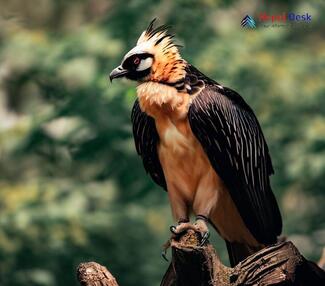Nepal, a country known for its diverse wildlife and breathtaking landscapes, is home to one of the most intriguing birds of prey – the Bearded Vulture (Gypaetus barbatus). Often referred to as the "Bone Breaker", and also known as the lammergeier and ossifrage, this fascinating bird plays a unique role in the ecosystem of this mountainous region. It is the only member of the genus Gypaetus. Traditionally considered an Old World vulture, it actually forms a separate minor lineage of Accipitridae together with the Egyptian vulture. In this article, we will take a closer look at this magnificent creature and the role it plays in keeping the environment balanced in the skies of Nepal.
Adapted for High Altitude Living
The Bearded Vulture is found throughout Europe, Asia, and Africa, but its presence in Nepal is particularly noteworthy. With their massive wingspan reaching up to 2.9 meters, these birds glide effortlessly through the high-altitude Himalayan air. Thanks to their specially adapted physiology, they can soar at elevations exceeding 26,000 feet—a skill that not many bird species can boast.
An Unusual Diet
What sets the Bearded Vulture apart from other birds of prey is its peculiar diet. Instead of hunting small animals or birds like most raptors, they primarily feed on bones. They locate carcasses from remarkable distances and devour marrow-filled bones with supreme efficiency.
In fact, their strong stomach acid allows them to digest these bones within 24 hours. When faced with large or difficult-to-swallow bones, these intelligent birds employ an astonishing technique: they lift the bone several meters into the sky and drop it onto a hard surface to break it into more manageable pieces.
Playing A Vital Role in The Ecosystem
By consuming leftover bones from carcasses, Bearded Vultures play a significant role in maintaining Nepal's ecosystem. Firstly, their behavior helps reduce waste and prevents rotting remains from contaminating soil or water sources. Moreover, by consuming bones and eliminating potential breeding grounds for disease-carrying insects, they keep the environment cleaner and healthier for other species.
A Conservation Concern
Although Bearded Vultures are not considered endangered on a global scale, their population in Nepal does face serious threats. Illegal hunting, habitat degradation, and unintentional poisoning due to consuming carcasses containing veterinary drugs are some of the challenges these birds face daily. Consequently, organizations like the International Centre for Integrated Mountain Development (ICIMOD) and Bird Conservation Nepal are collaborating to run conservation projects aimed at safeguarding this fascinating species for future generations.
In conclusion, the Bearded Vulture (Gypaetus barbatus) is a truly unique bird that plays a crucial role in maintaining Nepal's ecosystem balance. As we continue to appreciate the beauty of our natural world, it's crucial to support conservation efforts to protect these majestic creatures and their habitats. So, next time you find yourself gazing up at the skies of Nepal, keep an eye out for these incredible bone-breaking birds – a sight you won't want to miss!




